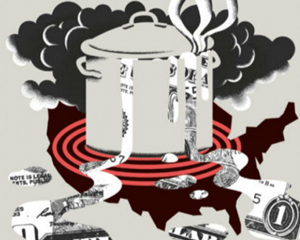Radiant energy
輻射能
If America's economy runs hot, what happens to the rest of the world?
如果美國經濟過熱,世界其他地區會發生什么?
When america sneezes, the rest of the world catches a cold. But what happens when it runs a fever? After a trying 2020 in which GDP fell by 3.5%, America is poised to enjoy a robust rebound in 2021 simply by returning to something like normal as vaccination proceeds. Yet it might manage more than just that. If President Joe Biden's covid-19 relief bill is enacted, total stimulus this year may exceed $2.5trn. That could easily push output above what the Congressional Budget Office estimates to be its "potential" level: that is, the amount the economy can produce without an increase in inflationary pressure. This possibility has some American economists on the lookout for signs of accelerating growth in prices and wages. America does not operate in a vacuum, however; should overheating occur, its effects will not be con- fined within its borders. Depending on how the recovery plays out, a hot American economy could be a boon for the rest of the world—or yet another source of concern.
當美國打噴嚏時,世界其他地方就會感冒。那么它感冒時會發生什么呢?2020年美國經歷了艱難的一年,GDP下降了3.5%。而隨著疫苗接種的進行,一切回歸正常,那么美國有望在2021年實現強勁反彈,而且可能會反超。如果拜登總統的新冠救助法案獲得通過,今年的刺激總額可能會超過2.5萬億美元。這很容易使產出超出國會預算辦公室估計的“潛在”水平:即在通脹壓力不增加的情況下經濟能夠產出的總量。這種可能性使得一些美國經濟學家在尋找物價和工資加速增長的跡象。然而,美國并不是在“真空”中運作,如果出現過熱,其影響將不會局限于國內。美國經濟的繁榮對世界其他國家來說可能是福音,也可能是另一個擔憂的來源,這取決于經濟復蘇的結果。

In a closed economy that does not trade with the rest of the world, too little spending leads to job losses and downward pressure on prices, whereas too much should push up employment and, eventually, prices. In an open economy, however, some of the effects of the shifts in demand spill over to the rest of the world. A sharp drop in spending, for instance, may be associated with plunging demand for imports, in which case some of the pain of a slump is exported abroad. During the global financial crisis of 2007-09, troubles in financial markets wreaked havoc all over the world, but even countries relatively insulated from those woes felt a chill thanks to trade links with America and Europe. According to one estimate, about a quarter of the drop in American demand and a fifth of the fall in European demand was borne by other economies, and transmitted through trade.
在一個不與世界其他地區進行貿易的封閉經濟體中,支出過少會導致失業和價格下跌壓力,而支出過多則會推高就業率,最終推高價格。然而,在一個開放的經濟體中,需求變化的一些影響會溢出到世界其他地區。例如,消費的急劇下降可能與進口需求的急劇下降有關,在這種情況下,經濟衰退帶來的一些痛苦會出口到國外。在2007年至2009年的全球金融危機期間,金融市場的問題在全球范圍內造成了嚴重破壞,但由于美國和歐洲的貿易聯系,即使是那些與這些災難相對隔絕的國家也感受到了寒意。據估計,美國需求下降的四分之一和歐洲需求下降的五分之一是由其他經濟體承擔的,并通過貿易傳導。
A boost to demand ought to work in a similar way, but in the other direction. As Americans spend more, some of it leaks abroad: through purchases of foreign goods, for example, or spending on services—including tourism, which should begin to rebound as pandemic restrictions are lifted. An analysis of fiscalpolicy spillovers published by the IMF in 2017 found that an American stimulus consisting mostly of spending (as opposed to tax cuts) and worth 1% of GDP raises the output of the average country by 0.33% in the first year. Countries with closer trade ties experience bigger effects; the fillip to Canada's economy is estimated to be almost three times the average, for example. If the combination of reopening and stimulus invigorates the American consumer, the effects could quickly be felt all over the world.
刺激需求應該以類似的方式發揮作用,但方向相反。隨著美國人消費的增加,其中一部分消費會流向國外:例如,通過購買外國商品,或者在服務方面的支出——包括旅游——隨著新冠限制的解除,旅游業應該會開始反彈。國際貨幣基金組織在2017年發布的一份關于財政政策溢出效應的分析報告發現,美國的刺激計劃主要由支出(而不是減稅)組成,占GDP的1%,第一年能使國家的平均產出提高0.33%。貿易聯系越緊密的國家影響就越大。例如,據估計,加拿大經濟的刺激幾乎是平均水平的三倍。如果重新開放和刺激措施的結合能刺激美國消費者,那么其影響很快就會波及到全世界。
譯文由可可原創,僅供學習交流使用,未經許可請勿轉載。











